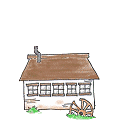posted 3 years ago
I took some time to review what I could on the construction of a berm shed. It is quite possible I missed some points, but here is what I could see: The half shelf lap joints on top of the vertical posts does not appear to provide a positive connection to allow lift forces to be carried into the ground. It was also not clear if the posts were set with a stone chocking for at least 4 feet below the surface or set into concrete or anchored by bolts to a concrete footer. From the cost, probably few if any of those. This creates a potential weakness that might allow a large tornadic event to lift the roof and at least bang it around a bit. The load along the back and on top will help, but I worked the Greensburg, KS EF-5 and wonder since you are too close for comfort to that kind of beast if a structure built without a strong continuous load path may fail. In addition, I see the rear wall on the berm shed comprised of horizontal logs. Now, they are separated from the dirt, which is good, but a better orientation for a couple of reasons would be to make the rear wall all vertical logs. That was a Quebec design, but using vertical poles would allow reversing each pole to allow use of smaller poles (quicker and easier) while allowing those vertical poles to provide support in both directions. Use of rope would provide a flexible connection that would provide both uplift and gravity support. The Egyptians used ropes to hold their boats together and it seems to have been a great method. With horizontal rear poles, only the upper pole would provide a load path connection, while with vertical poles, held with a flexible connector would provide a load path for the entire rear wall from ground to horizontal pole. Additionally, if one travels the woods much, it is clear that logs that lie down rot far faster than those that remain standing.
The half shelf lap over vertical pole along the front (or back, I assume) would be better oriented on its side with the connection for the two horizontal poles fastened with an oak tenon (old time versions used a cross piece through the smaller end to provide wind vibration resistance. If one wished to increase the load path connection, then a good rope wound around the horizontal beam and carried down to the vertical one would significantly increase upward resistance. Far more than any of the vertical smooth bars I noted being placed, if any were placed at all, for those joints. An alternative might be to run strap iron over the horizontal and fasten to the vertical pole. Just make sure that any nails or anchor holes on the vertical pole are offset. Wood poles do not split nearly as easily with offset holes than with holes that are aligned.

 3
3




 4
4




 6
6




 7
7




 3
3




 2
2




 2
2












